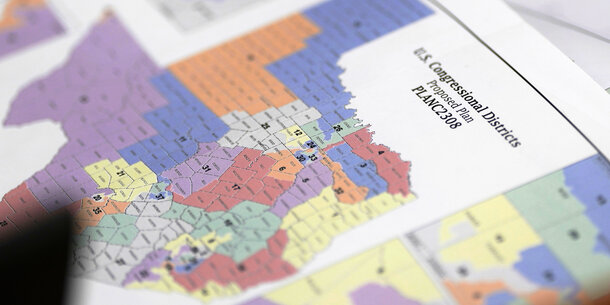Ohio’s 2024 Republican primary for the U.S. Senate dominated headlines and set the stage for a competitive showdown between the victor, Bernie Moreno, and Democratic incumbent Sen. Sherrod Brown in the general election. But downballot, uncontested races and uncompetitive districts that all but guarantee victory to one party will leave millions of Ohio voters with little sway over state house elections this November.
The lack of competition in Ohio legislative races is hardly a surprise. Ohio has long been one of the most gerrymandered states in the country, and its current maps are no exception. When map drawers gerrymander district boundaries, their goal is to lock in their desired election outcomes and leave voters without a meaningful choice. And that is exactly what Ohio’s politicians have done.
More than 9 million Ohioans (about 77 percent of the state’s population) live in districts where elections for state representatives are not in serious dispute. That is, these districts are either uncontested,1or they give one party a disproportionate advantage in the general election so that the district is uncompetitive, even if it’s formally contested. Making matters worse, nearly half the districts in the 99-member Ohio house didn’t feature a primary contest to nominate this November’s presumptive winner. In other words, for half the state’s legislative races, the passage of the candidate filing deadline is expected to be the main event of the election, long before a vote is cast in the primary or the general election.
This resource examines the realities for voters in elections under gerrymandered maps in Ohio: uncontested districts, uncompetitive districts, and few meaningful primaries.
Uncontested districts
This November, almost 1.8 million Ohioans will find themselves in uncontested state legislative districts that feature only one major party candidate. In all, there are 15 districts (out of 99 total) that will give voters no choice between Democratic and Republican candidates for state representative.2
Worse still, 11 of these 15 districts did not feature any competition in the March 19 primary election either.3As a result, approximately 1.3 million Ohioans will see only one major party candidate through the 2024 election cycle across both the primary and general elections.
Uncompetitive districts
With 15 districts uncontested, 84 districts for the Ohio General Assembly will feature candidates from both major parties.4But because 62 of the districts contested in the general election have been drawn as safely Republican or Democratic seats, where the favored party can be expected to win 55 percent or more of the vote, their outcome in the general election is not in serious dispute.5As a result, about 9.1 million Ohioans — 77 percent of the total population — live in districts that will be uncontested or uncompetitive this November.
In addition to the 11 uncontested districts without primary competition, 36 uncompetitive districts did not feature primary competition for the favored party’s nomination.6That means outcomes in almost half (47 out of 99) of Ohio’s state house districts were all but locked in when the partisan candidate filing deadline passed on December 20, 2023.7
Low primary turnout in uncontested and uncompetitive districts
In both uncontested and uncompetitive districts, primary elections have increased importance because they are either actually or effectively outcome determinative. Across these two district types, there were 30 state house districts that had contested primaries last month. But low turnout across these districts means only a small fraction of the electorate selected the presumptive representative.
On average, only 18.8 percent of registered voters cast ballots in the primaries across these districts.8As a result, fewer than 450,000 voters all but decided who would serve as state representatives on behalf of more than 2.3 million registered voters and 3.5 million constituents.
• • •
An overwhelming majority of Ohioans will cast ballots this November in legislative districts that were drawn to lock in general election outcomes, and few districts featured meaningful primary contests. These are the predictable consequences of living in a gerrymandered state. But it may be the last such election cycle in the state. If the Citizens Not Politicians campaign to reform Ohio’s redistricting process succeeds this November, a new citizen-led redistricting process will draw new district maps that center community needs and voter preferences rather than the interests of incumbents.
Endnotes
-
1
Uncontested districts are defined as those where there will be either a Republican or Democratic candidate on the general election ballot, but not both. -
2
See Appendix 1A. -
3
If a declared candidate’s only primary challengers were write-in candidates, the declared candidate is considered to have run in an uncontested primary. Voters in Ohio must manually enter the names of write-in candidates, so members of the electorate only saw one name on their ballots last March. Dawes, “How write-in candidates work in Ohio, with 2 on local ballots in March,” Dayton Daily News. -
4
In 10 of the 84 contested districts, one of the major party candidates on the ballot was written in by voters. Other than incumbent Rep. Terrence Upchurch’s write-in candidacy, which was a special circumstance (he did not meet the regular candidate filing requirements), none of the other write-in candidates who advanced to the general election received more than 527 votes. -
5
If a district is at least 55 percent Republican or Democratic, it is considered uncompetitive because it is likely out of reach for a candidate from the other party except under exceptional circumstances. The partisan composition of each legislative district is calculated using a composite of the two-party vote from all Ohio statewide elections from 2016–2022, consistent with Art. 11 § 6B of the Ohio Constitution. See Appendix. -
6
Like in uncontested districts, candidates in this 55 percent band of competition are generally considered to have run uncontested in their party’s primary if their only competition was a write-in candidate. -
7
Frank LaRose, Ohio Candidate Requirement Guide (Columbus, OH: Ohio Secretary of State, August 2023), 9, https://www.ohiosos.gov/globalassets/publications/election/2024_crg.pdf. -
8
See Appendix.




